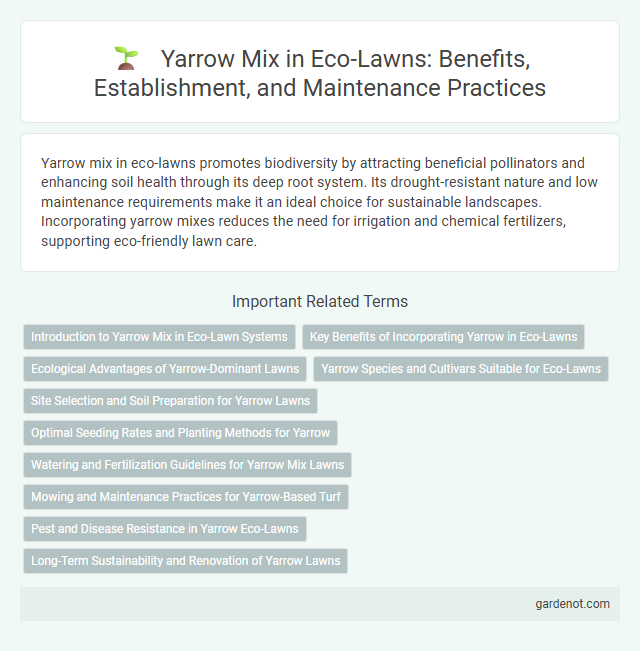Yarrow mix in eco-lawns promotes biodiversity by attracting beneficial pollinators and enhancing soil health through its deep root system. Its drought-resistant nature and low maintenance requirements make it an ideal choice for sustainable landscapes. Incorporating yarrow mixes reduces the need for irrigation and chemical fertilizers, supporting eco-friendly lawn care.
Introduction to Yarrow Mix in Eco-Lawn Systems
Yarrow mix in eco-lawn systems consists of Achillea millefolium varieties known for drought tolerance and low maintenance. This blend promotes biodiversity, attracts pollinators, and supports soil health through deep root systems. Its resilience to foot traffic and adaptability to various soil types make it an ideal component of sustainable lawn alternatives.
Key Benefits of Incorporating Yarrow in Eco-Lawns
Yarrow mix enhances eco-lawns by improving soil health through natural nitrogen fixation and deep root systems that reduce erosion. Its drought tolerance and pest-resistant properties decrease the need for irrigation and chemical treatments, promoting sustainable lawn care. The vibrant blooms attract pollinators, boosting local biodiversity and supporting ecosystem resilience.
Ecological Advantages of Yarrow-Dominant Lawns
Yarrow-dominant lawns enhance biodiversity by providing habitat and nectar for pollinators such as bees and butterflies. Their deep root systems improve soil health and water retention, reducing the need for irrigation. Yarrow's natural drought tolerance and resistance to pests minimize the use of chemical fertilizers and pesticides, promoting a sustainable and eco-friendly lawn.
Yarrow Species and Cultivars Suitable for Eco-Lawns
Yarrow species such as Achillea millefolium are highly suitable for eco-lawns due to their drought tolerance, low maintenance, and ability to improve soil health with nitrogen-fixing properties. Cultivars like Achillea millefolium 'Paprika' and 'Cerise Queen' offer vibrant floral displays while supporting pollinators and enhancing biodiversity in sustainable lawn systems. Selecting native and well-adapted yarrow cultivars promotes resilient eco-lawns that require minimal irrigation and chemical inputs.
Site Selection and Soil Preparation for Yarrow Lawns
Yarrow lawns thrive best in well-drained, sandy or loamy soils with full sun exposure, making site selection critical for optimal growth and drought resistance. Prior to planting, soil should be tested and amended with organic matter to enhance fertility and ensure a pH between 6.0 and 8.0, which supports healthy yarrow root development. Proper soil preparation reduces weed competition and promotes a dense, resilient yarrow turf suitable for eco-lawn applications.
Optimal Seeding Rates and Planting Methods for Yarrow
Optimal seeding rates for Yarrow in eco-lawns typically range from 5 to 10 pounds per acre to ensure robust ground coverage without overcrowding. Planting methods such as broadcast seeding or shallow drilling at a depth of 1/8 to 1/4 inch promote effective germination and establishment. Proper soil preparation and maintaining consistent moisture further enhance growth and long-term sustainability of Yarrow within mixed species eco-lawns.
Watering and Fertilization Guidelines for Yarrow Mix Lawns
Yarrow mix lawns require minimal watering, thriving best with deep irrigation sessions spaced weekly to encourage drought tolerance. Fertilization should be limited to low-nitrogen, slow-release formulations applied in early spring to support healthy growth without promoting excessive leafiness. Overwatering and high-nitrogen fertilizers can lead to weak stems and reduced flowering, so balanced care is essential for vibrant, resilient yarrow lawns.
Mowing and Maintenance Practices for Yarrow-Based Turf
Yarrow-based turf requires mowing at a higher height of 3 to 4 inches to promote healthy growth and prevent stress on the plants. Regular mowing intervals of 10 to 14 days help maintain a uniform appearance and encourage dense turf development. Minimal irrigation and reduced fertilizer application enhance the eco-lawn's sustainability while supporting yarrow's drought-tolerant nature.
Pest and Disease Resistance in Yarrow Eco-Lawns
Yarrow in eco-lawns offers robust pest and disease resistance due to its natural compounds that repel common garden pests such as aphids and spider mites. Its deep root system enhances soil health, reducing vulnerability to fungal infections and root rot. This resilience makes yarrow mixes an ideal choice for sustainable, low-maintenance eco-lawns.
Long-Term Sustainability and Renovation of Yarrow Lawns
Yarrow mix enhances eco-lawn sustainability by improving soil health through nitrogen fixation and drought tolerance, reducing the need for frequent watering and chemical inputs. Its deep root system supports long-term lawn renovation by stabilizing soil structure and promoting natural regeneration after damage or compaction. Regular overseeding with yarrow mix maintains biodiversity and resilience, ensuring a sustainable and low-maintenance lawn ecosystem over time.
Yarrow mix Infographic

 gardenot.com
gardenot.com